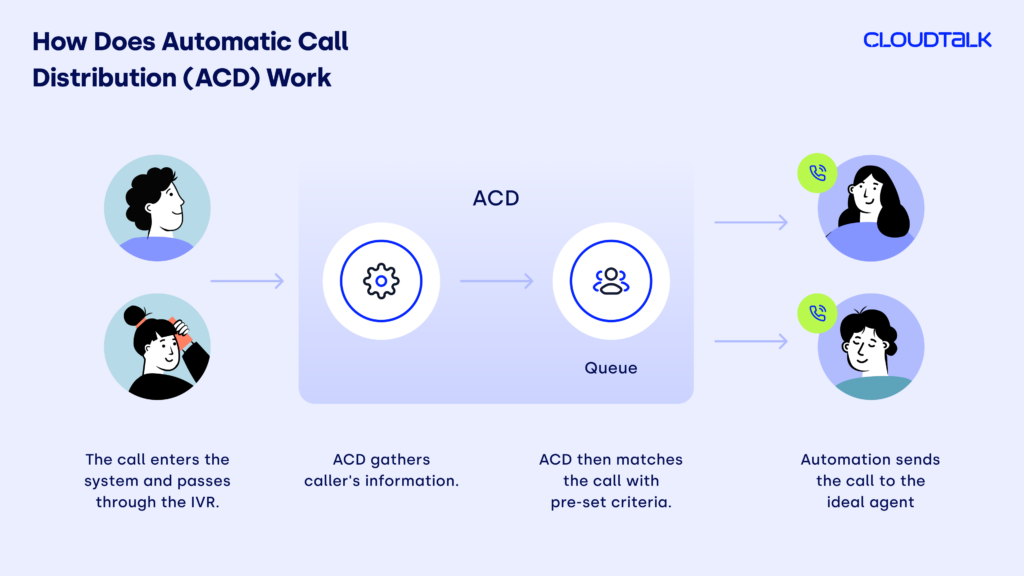Feature Explained: What ACD Means in Call Centers
The call center industry standard says you should be answering 80% of calls in 20 seconds*. But how? That’s where Automatic Call Distribution comes in.
When you dial a business service line, you hope to connect quickly with just the right person—someone who knows exactly how to help you. This doesn’t have to be a matter of luck; it’s something that can be intentionally created.
Automatic Call Distribution, or ACD, can make that happen. Think of it as a high-tech traffic controller, directing each call to its ideal match: the agent who’s skilled, available, and ready to handle your issue. And the best part: this is done before you even say “Hello.”
Curious how this works behind the scenes? Let’s dive into what makes this technology essential for today’s call centers and see how it turns each call into a faster, more efficient experience.
Key takeaways:
- Automatic Call Distribution is a call-routing technology used in call centers to direct incoming calls to the most suitable agent or department based on pre-set rules. It’s designed to ensure calls are handled efficiently and routed quickly.
- With over 60% of consumers unwilling to wait on hold for even a minute, efficient call routing becomes crucial. ACD systems reduce wait times, manage high call volumes, and streamline the customer journey.
- ACD efficiently matches callers with the right agent based on skills, priority, or availability. This tailored approach meets the expectations of 75% of customers who believe live assistance offers the best experience.
Get a head start with 50% off your first month.
What’s ACD All About?
ACD, or Automatic Call Distribution, is a smart call-routing system that directs incoming calls to the best department or agent in a flash, based on preset rules. This powerhouse tech ensures customers reach the right person right away—ideal for handling high call volumes or after-hours calls without a hitch.
ACD isn’t the same as IVR, though. While IVR offers menu options and collects info directly from callers, ACD works behind the scenes, distributing calls based on pre-defined rules. Need all after-hours calls sent straight to voicemail? Want VIP customers routed directly to your most experienced agents? ACD’s got it covered.
Often, ACD and IVR work together within call center software. IVR greets the caller, gets the basics, then ACD takes over, ensuring a smooth and targeted handoff to the right agent. It’s the dream team for top-notch efficiency and caller satisfaction.
Types of Automatic Call Distribution
ACD call center systems come in a variety of flavors, each tailored to different needs. Here’s a quick rundown of the main types:
#1 Round-Robin Distribution Method
- What it is: This method sends calls to agents in a rotating order. It’s like giving everyone a turn, ensuring no single agent gets overloaded (or bored!).
- When to use it: Perfect for balancing the workload, maintaining an even workload across the team and preventing any single agent from becoming overwhelmed.
#2 Skills-Based Routing in ACD
- What it is: Skills-based routing sends calls to agents with the right expertise—ideal for tech support or language-specific inquiries.
- When to use it: Trying to ensure Spanish-speaking customers connect only with bilingual agents? This is best used in call centers that cater to diverse customer needs.
#3 Priority-Based Call Distribution
- What it is: Routes calls according to their priority level, ensuring high-priority calls are handled first.
- When to use it: Some calls need extra attention. With priority-based routing, VIP clients or urgent inquiries are first served at the front line.
#4 Fixed Order
- What it is: This approach follows a strict order, always routing calls to the same agents in the same sequence.
- When to use it: Suitable for call centers where certain agents are assigned to specific tasks or client accounts, ensuring consistent service for repeat callers or specialized issues.
#5 Availability-Based
- What it is: It connects incoming calls to the first available agent, reducing customer wait times.
- When to use it: Best for busy call centers with high call volumes where quick response time is critical, such as customer service hotlines or sales teams aiming to maximize answered calls.
#6 Simultaneous
- What it is: In simultaneous distribution, all agents are notified of an incoming call at once, and the first one to pick up takes it.
- When to use it: Ideal for high-priority customer service lines or emergency support centers. It’s a speed-focused approach for high-priority lines.
#7 Weighted
- What it is: It assigns more calls to specific agents based on their experience or productivity, distributing calls according to a weighted system.
- When to use it: Perfect for call centers that want to prioritize experienced agents or top performers for certain types of calls, ensuring high-value interactions are managed by the most capable agents.
#8 Idle Time-Based
- What it is: It routes calls to the agent who has been idle the longest, distributing workloads evenly.
- When to use it: Useful for call centers that want to maintain fairness in call distribution and keep agents engaged, preventing some agents from being overloaded while others wait idly.
For more on this topic, check out our resource on the best lead distribution & lead routing tools.
Is your Call Routing smart enough? Discover what IVR can do for your ACD.
But How Does Automatic Call Distribution (ACD) Work Exactly?
When a call comes in, the ACD system analyzes it based on pre-set criteria—things like the time of day, caller location, or language preferences—and then directs it to the most suitable agent or department.
To make this easier to understand, imagine someone calling a company that uses an ACD. The call would go through a flow like this:
- The call enters the system and passes through the initial call center software layer, often the Interactive Voice Response (IVR) system.
- Using IVR or other tools, ACD gathers information like the caller’s language or reason for calling.
- ACD then matches the call with pre-set criteria, choosing the best routing strategy. Options like Skills-Based Routing or Caller-Based Routing ensure the right fit.
- Based on the rules, Workflow Automation sends the call to the ideal agent—whether they’re available now or skilled in the needed area.

How (and Why) You Should Use an Automatic Call Distribution System in a Call Center
Using an Automatic Call Distribution (ACD) system in your call center isn’t just about routing calls; it’s about creating a faster, more satisfying journey for callers—every time.
Here’s how CloudTalk has helped call centers streamline processes and enhance satisfaction with real-life examples from our customers.
Routing Incoming Calls to the Most Suitable Agents at All Times
By integrating ACD with their IVR, DiscoverCars reduced wait times by 80%, ensuring callers connected with the right agents promptly. This approach allowed them to handle incoming inquiries more efficiently, reducing transfer rates and improving response accuracy.
“The benefit we value the most is the call routing. With the IVR, we route customers to agents who speak their language. We can also distribute calls based on the customers’ stage in the booking process, giving higher priority to those clients who are picking up their cars.”
– Issam Daoudi – Supervisor at DiscoverCars
Integrating ACD with Other Advanced Call Center Features
An effective ACD system is even more powerful when it works alongside tools like CRM integrations. Leadspicker, for example, accelerated their sales cycle by 92% by leveraging CloudTalk’s Analytics features, paired with integrations like Pipedrive. By providing agents with comprehensive caller insights, Leadspicker enabled a more personalized approach, ensuring calls are handled efficiently and relevantly.
Identifying “VIP Callers” and Blacklisted Numbers
When it comes to VIPs, keeping them waiting is a no-go—after all, they’re not calling to enjoy your hold music, right? Distinguishing between VIP customers and disruptive callers is vital for an efficient call flow. With ACD systems, companies can easily tag high-priority clients and flag blacklisted numbers. This means that VIP callers bypass standard queues, reaching specialized agents faster, while unwanted calls are filtered out, freeing up agents’ time.
Increasing Agent Productivity
Allowing agents to focus on calls that best match their skills minimizes unnecessary transfers and boosts efficiency. MyHeritage scaled its outbound call volume by 49% and reduced missed calls by 21% after implementing CloudTalk. By keeping agents engaged with relevant tasks, ACD improves overall productivity and job satisfaction.
“We have seen a significant increase in our outbound call volume since we started using CloudTalk. We can now reach out to more prospects and customers than ever before, which has helped us grow our business and expand our user base.”
– Elay Sasson — Call Center Sales Manager at MyHeritage
Keeping Distributed Agents Together
For remote teams, ACD is a lifesaver. Cloud-based systems keep agents connected, no matter where they’re dialing in from. Calls are routed seamlessly, as if everyone were in the same room, ensuring that every agent is in sync and ready to jump in when needed. It doesn’t matter if your team is spread across cities—or continents—communication stays smooth, and customers get uninterrupted support every time.
Preventing Long Wait Times & Call Overflow
Long hold times are a customer’s worst enemy and can take a toll on satisfaction scores. A well-designed ACD system tackles this head-on, managing call overflow and routing calls efficiently, even during high-traffic periods. By directing calls to available agents, ACD minimizes delays and keeps response times sharp.
Improved Customer Satisfaction
At the end of the day, all these benefits point to one thing: happier customers. Polysleep saw measurable improvements in customer satisfaction by spending over 4,000 additional minutes on calls with CloudTalk, creating smoother and more meaningful interactions. By streamlining call routing and enhancing customer interactions, ACD fosters long-term loyalty and positive feedback.
ACD Potential Implementation Challenges
Implementing Automatic Call Distribution (ACD) can be a game-changer for your call center, but getting it right isn’t always straightforward. Here are some common challenges that can pop up and how to handle them.
Complexity in Setting Up Rules
Setting up rules can be a real puzzle on some platforms—especially when you’re managing a variety of call types, languages, or unique workflows. But with CloudTalk’s intuitive interface and tools, like the Call Flow Designer, configuring these rules becomes a breeze. CloudTalk lets you visualize each step, drag-and-drop adjustments, and easily customize routes, making complex setups feel natural.
Integration with Existing Systems
Integrations with existing call center software or CRM can be tricky. Mismatches or outdated systems can lead to disruptions, so making sure your ACD setup is compatible with current tools is crucial. Opting for a flexible, cloud-based ACD like CloudTalk helps to bridge this gap smoothly.
Staff Training and Adjustment Period
ACD often brings a new workflow for agents, especially if they’re used to manual call handling. Without the right training, agents might feel overwhelmed or miss out on key features. A little upfront training can go a long way to ensuring your team is comfortable with new processes and knows how to leverage the features.
Maintaining Data Accuracy
ACD needs accurate, up-to-date caller data to work at its best. Outdated or incorrect data can throw off the routing system, causing misdirected calls and unhappy customers. Implementing a regular data-cleaning process and utilizing workflows can help you keep things on track.
Handling High Call Volumes
ACD is designed to streamline call flow, but during peak times, routing can still get congested. Overloaded lines or insufficiently prepared backup agents can lead to delays. To counteract this, build a scalable routing strategy that considers surge periods and includes a reliable backup system, like Caller-Based Routing.
While these challenges might seem daunting, the right ACD provider can help navigate them. Planning ahead, training your team, and staying adaptable ensures ACD becomes an asset, not a hurdle, for your call center’s success.
People want to talk to people (who solve their problems)
Highlighting the importance of people after praising the impressive technologies available for call centers might seem contradictory. Yet, many companies overlook the fact that they are dealing with real people.
The truth is that customers don’t want to talk to machines for too long. 67% of them hung up the phone out of frustration because they couldn’t talk to a real person. And it better be the right one because nobody likes being passed around from agent to agent, repeating themselves over and over again.
That’s why choosing the proper Automatic Call Distribution (ACD) provider is so important. Coupled with the right number of IVR menus (be careful not to overdo it), they shorten the path between consumers and the most suitable agents, making life easier on both sides of the call.
At the end of the day, every call counts. Over 50% of customers will turn to a competitor after just one poor experience. So, don’t make a mistake. Choose CloudTalk as your call center solution.
Setting up rules can be a real puzzle on some platforms—especially when you’re managing a variety of call types, languages, or unique workflows. But with CloudTalk’s intuitive interface and tools, like the Call Flow Designer, configuring these rules becomes a breeze. CloudTalk lets you visualize each step, drag-and-drop adjustments, and easily customize routes, making complex setups feel natural.
Sources:
See CloudTalk in Action
FAQs
What does ACD stand for?
ACD stands for Automatic Call Distribution.
What is ACD service?
An ACD service is a call routing system that directs incoming calls to specific agents or teams based on criteria like availability, skill set, or customer type. It’s designed to minimize wait times and optimize customer interactions by connecting callers with the right support as quickly as possible.
What is the meaning of ACD in WFM?
In Workforce Management (WFM), ACD refers to Automatic Call Distribution systems that help allocate calls efficiently, ensuring that agents are available and properly scheduled to handle varying call volumes.
What is the difference between ACD and IVR?
The primary difference is that ACD directs calls to agents based on routing rules, while IVR (Interactive Voice Response) interacts with callers through a menu to gather information or allow them to select options. IVR can be used in tandem with ACD to gather caller details first, which ACD then uses to route the call effectively.
How are ACD calls handled?
ACD calls are handled based on customized routing rules, which can include factors like agent skill, availability, language, or caller priority. The system routes each call to the most appropriate agent, reducing transfers and speeding up resolution times.
























